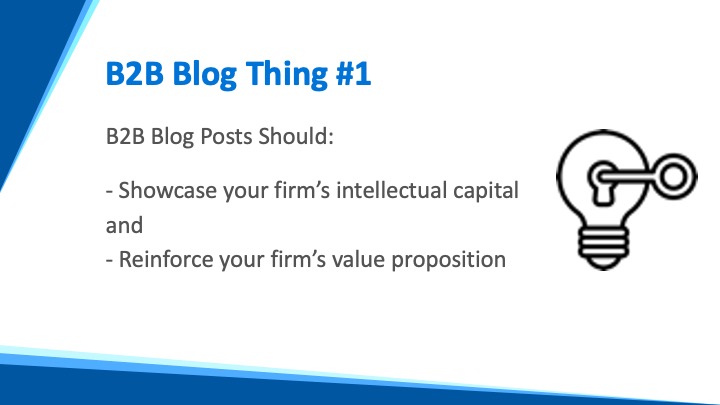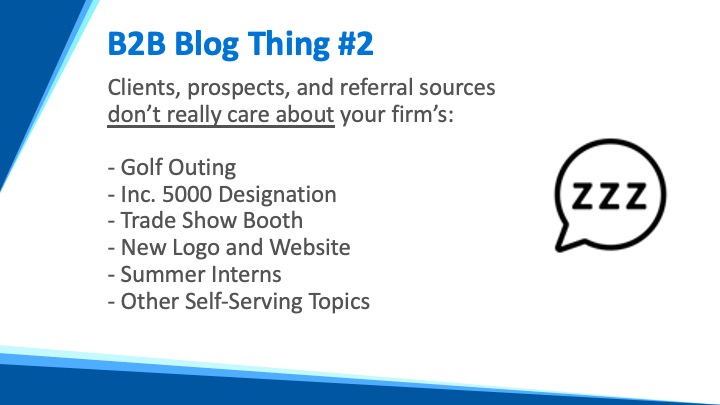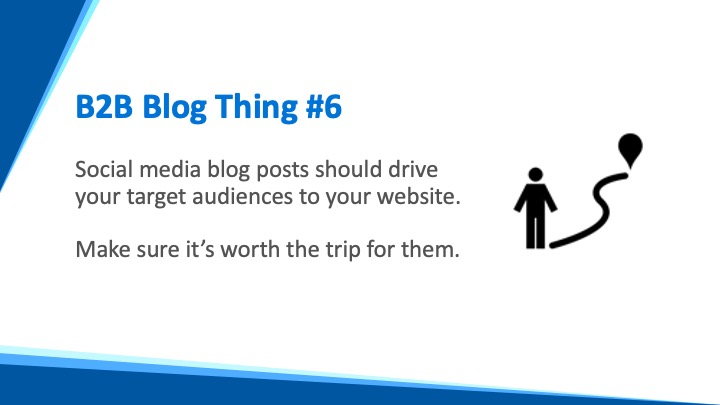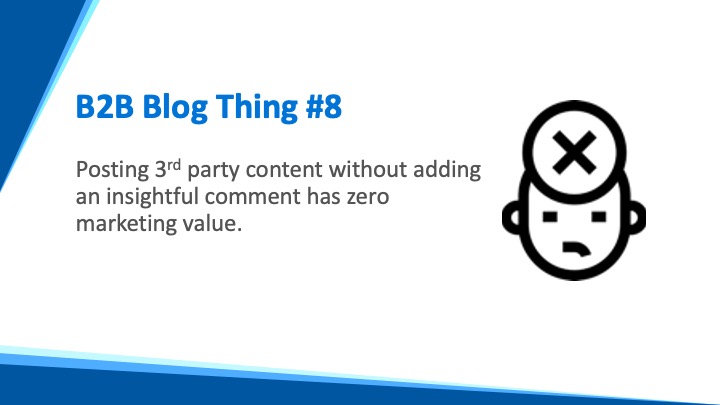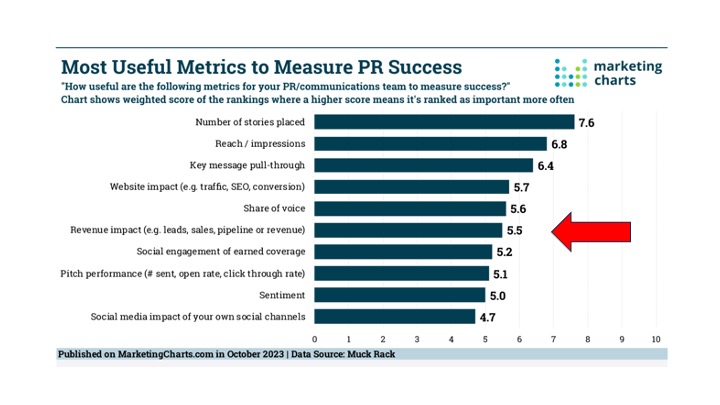Many B2B blogs lack strategic focus; wasting time, money, and opportunities to engage with target audiences. Is it time to rethink your blog?
Tag Archives: B2B marketing
To Win New Clients, Your B2B Firm Needs to Understand “Career Risk”

In a perfect world, the most experienced and qualified B2B firms always win the business.
But in our real world, prospects apply a very different selection factor.
Prospects will always be more concerned with the career-related risks involved in hiring any outside resource. Bluntly, they fear that if the firm they select fails, then they will pay a price.
What’s the price they can pay?
Taking the blame for a selection that wastes time, money, and opportunity can affect their career advancement, their salary & bonus, and even result in termination.
A prospect’s career risk management strategy will always be to select the “safe choice,” (usually the largest or best-known candidate) when picking an outside advisor. Qualifications are far less important.
HOW CAN YOUR FIRM AVOID BEING A VICTIM OF CAREER RISK?
To address career risk, and to win clients, your top marketing priority is to position your B2B firm as a safe choice.
Here’s what that means:
1. Creating “Credibility Tools” that provide direct or indirect 3rd party endorsements
2. Making those credibility tools highly visible and easy to find on your firm’s website
3. Providing solutions to challenges and opportunities that “safer” competitors can’t deliver
To learn how to position your B2B firm as a safe choice (and other capabilities you need to grow your business), here’s a link to a complimentary webinar.
Filed under B2B Marketing
Why Most B2B Firm PR Strategies Fail to Deliver Tangible Results
PR (or “earned media”) is the most powerful form of content marketing, because of its potential market reach, online visibility, and inherent 3rd party endorsement.
Unfortunately, most B2B firms fail to achieve a return on their PR investment, for 3 reasons:
🏴 Most B2B firms are focused on the quantity, rather than the quality, of their media placements. As the chart below reflects, “Revenue Impact” ranks as only the 6th (out of 10) most important success metric. It should be the most important metric.
🏴 Most B2B firms are seeking the WRONG kind of earned media. For example: one-off quotes in news stories, pay-to-play articles in any type of publication, and pickup from most press releases are worthless. The most valuable type of earned media is bylined articles in respected business and industry trade publications that showcase your firm’s intellectual capital.
🏴 Most B2B firms don’t understand that the strategic purpose of earned media is to generate a “credibility tool” that should be used to engage with target audiences and shorten the sales cycle. Most firms simply post media placements on their social media and website like a hunting trophy…which has little practical value.
If your firm would like to learn how to improve the return on its PR investment, let us know how we can help.
Filed under Key Performance Indicators, Marketing Strategy
Client Newsletters for B2B Firms Is Content that’s Dead on Arrival

Client newsletters are one of the most widely used, and often abused marketing tactic for B2B firms of any size. Here are three myths and realities to help your firm determine whether it’s a worthwhile tool, or how to improve your current newsletter.
MYTH #1: Your B2B Firm Needs a Client Newsletter
Marketers want you to believe that your firm needs a newsletter. But traditional newsletters – containing commentary ranging from client alerts on tax legislation, to “best of” awards, or who’s joined the firm – are not a marketing necessity. In fact, at many firms their client newsletter is a marketing albatross. Each issue involves a frustrating hunt for timely information of genuine interest. Some firms avoid this pain by slapping their logo on boilerplate content purchased from a 3rd party, but those firms can pay a bigger price, in terms of brand damage. It says to target audiences, “We value our relationship, but we don’t really care enough (or know enough) to showcase our own intellectual capital in a newsletter.”
REALITY #1: Your Firm Needs to Drive Top-of-Mind Awareness
The intrinsic purpose of tactics that communicate with clients, prospects and referral sources is to reinforce the perception that your firm is smart, trustworthy and prepared to help. Beyond keeping and growing existing clients, (and because less than 5% of your target market needs your firm’s services at any time) the primary marketing goal is to drive top-of-mind awareness with target audiences. That way, when a prospect is seeking assistance, there’s a greater likelihood your at least will be put on the “short list” of candidates. If that’s the goal, then consistency and quality of the communication are critical; neither of which necessarily require a newsletter format to accomplish.
___________
MYTH #2: People Want to Learn About Your Firm’s Success
It’s nice to think that clients and prospects really care about your firm’s growth and accomplishments. The sad truth is that your firm’s success is more important to your competitors, and to current and prospective employees, than it is to your clients. Blowing your own horn can also backfire. When your firm touts that a senior partner has just published a book and was a guest on CNBC, your target audiences may wonder why that partner isn’t focused on client matters, or whether the cost of his publicity tour will result in higher hourly rates.
REALITY #2: Your Clients, Prospects and Referral Sources Care about Themselves
Understanding that all people are self-interested can make you a better marketer. Rather than creating newsletter content that’s based on what you know, on what you’ve done or on what you can do, focus instead on the ideas, talents and accomplishments of your target audiences, regardless of whether your firm played any role in their success. This is a very tough concept for many B2B firms to understand and embrace: that the most powerful form of thought leadership does not involve pushing out your own ideas. Instead, it involves deciding what ideas merit the attention of your target audiences, as well as what voices are worth listening to. True thought leaders seek to manage the conversation, not to control it.
_________
MYTH #3: A Newsletter is a Cost-Effective Marketing Tactic
The old saw, “Cheap is dear” rings true when it comes to newsletters. If it’s created in-house, few firms actually track the hours required to research, write, edit, approve and publish their newsletter. If it consists of cut & paste content, few firms consider the inherent opportunity loss in producing a newsletter that very few people will read or respect. Regardless of its content, only a small number of professional service firms proactively work to expand their newsletter’s reach, to maintain an adequate CRM capability, or to proactively leverage readership analytics from open and click-thru rates, if their newsletter is delivered online. Even fewer firms ever survey their target audiences to ask if they find the newsletter of value.
REALITY #3: Your Marketing Requires More than a One-Way Conversation
Newsletters often are one-way conversations. A fundamental marketing objective is to engage clients and prospects in a conversation regarding their specific needs and opportunities. Despite all the buzz regarding social media, that channel also falls short in terms of engagement, as most blog posts go unread. If your firm’s traditional and social media marketing tactics do not serve as catalysts to drive face-to-face discussions and word-of-mouth referrals, then their “cost-effectiveness” can never be measured on any meaningful basis.
Here’s the acid test to determine if your client newsletter has any marketing value: stop publishing it…and see how long it takes for anyone outside of the firm to ask why they haven’t received your firm’s latest issue. Chances are that no one will.
If your B2B firm is seeking to showcase its intellectual capital, and drive market engagement, the traditional “all about us” newsletter is not the most effective way to accomplish those goals.
Filed under B2B Marketing
Why Content Marketing Will Continue to Fail in the Age of Artificial Intelligence (A.I.)

In the mid 1980s, with introduction of the Mac computer, PageMaker software, and the LaserWriter printer, the DeskTop Publishing system was born; for the first time allowing anyone to create print and online marketing materials that did not require a bona fide graphic designer or any elaborate printing hardware to produce physical documents.
This was a major technological advancement in the world of marketing communications. It also marked the beginning of a (ongoing) period that has produced some of the most incomprehensible, unattractive, and brand-damaging print and online marketing materials in the history of the communications.
DeskTop Publishing did not make people with no design talent or writing skills into graphic designers or copywriters. And based on the way content has been created and applied by most firms over the past decade, the availability of Artificial Intelligence will not make people more effective content marketers.
Here’s why:
- Most firms still don’t understand that marketing content is NOT about sales.
Blog posts or press releases extolling the features and benefits of your firm’s whiz-bang new product or service are more likely to be read by competitors than by prospects. White papers lost their credibility many years ago, because so many companies turned them into self-promotional sales brochures.
Your target audiences want objective, relevant, helpful information that addresses their challenges and opportunities, and enables them to draw their own conclusions regarding your firm’s ability to assist them.
- Most firms still don’t know how to extract or showcase their own intellectual capital.
Using ChatGPT to create a 500-word blog post may provide your company with the appearance of thought leadership, and remove some or all of the burden of drafting your own content. But AI-generated content will never be able to craft marketing content that’s based on your company’s unique experiences and perspectives that support its value proposition…which is what your clients, prospects and referral sources really want to know about.
- Most firms still create content that their target audiences don’t care about.
Your company understandably wants to demonstrate its investment in employees, or its commitment to charitable and civic causes. But in an online world where you have nanoseconds to catch market interest, content describing your company’s mud run, golf tournament, or wishing people a Happy Cat Lovers Day, is an enormous opportunity loss in terms of audience attention.
Find another platform for your internal news, and focus exclusively on addressing the “What’s In This For Me?” question that the outside world applies to all content.
Technology tools – whether it’s DeskTop Publishing or Artificial Intelligence – will never replace human (or corporate) experience, insights, talent, or creativity. Those tools are only of value in content marketing if you know how and when to apply them. The marketing profession’s track record suggest that more time should be devoted to strategy than to tactics.
Filed under Uncategorized
How to Grow Your B2B Firm by Making Every Employee a Sales Rep

Providing all employees with basic marketing and sales skills can help your B2B firm to grow and succeed. From the front desk to the corner office, “Every Employee a Sales Rep” should be fully ingrained as part of your company’s operating culture.
Many B2B firms – in legal, accounting, technology, financial services and consulting disciplines – employ at least one rainmaker, typically a founding member, who brings in the lion’s share of new business. But that “outside / inside guy” dynamic puts a company at risk, because rainmakers can depart unexpectedly (by choice or by ambulance), and the firm’s growth rate is always limited by their energy, motivation and availability.
More importantly, this business development model fails to leverage your firm’s “inside guys,” whose individual and collective business relationships, skills, experience and credibility should be harnessed to drive consistent revenue growth and to scale the company.
Regardless of their title, job description or capacity to work the room at a social event, every B2B firm employee should be given training, tools and ongoing support that empowers them to:
- Manage Their Personal Brand – Clients hire individuals, rather than a firm, to help them. To showcase their credentials, every client-facing employee should maintain a complete and up-to-date biographical profile on the company’s website and on LinkedIn. To expand their visibility, they should also participate in at least one activity unrelated to employment, whether that’s membership in the local chapter of a professional trade association, their daughter’s soccer team, or a fly fishing club.
- Articulate the Firm’s Value Proposition – Many employees, even at the senior level, do not have a clear understanding of what makes their firm different from the competition, and are at a loss to provide a compelling reason why someone should engage them. Every employee should know their firm’s “elevator pitch,” and be prepared to recite it whenever someone asks, “So…who do you work for?”
- Nurture Their Professional Network – Every employee has a network of current and former clients, associates in other disciplines, friends, relatives, neighbors and individuals they’ve met at conferences or social events. Business contacts are often included in the firm’s CRM system, and may receive quarterly newsletters or other communications issued by the company. But client-facing employees should also maintain direct and regular contact with their entire personal network to nurture and expand those relationships, because referrals are driven by casting a wide net.
- Drive Top-of-Mind Awareness – The marketing challenge for most B2B firms is making the short list of candidates called in for an assignment. To increase the odds of getting that call, your firm must constantly sow seeds with clients, prospects and referral sources, driving top-of-mind awareness regarding its capabilities and credentials. Employees who possess the firm’s intellectual capital should play an active role in generating relevant content that can keep the firm in play.
- Sell Intrinsically – The “inside guys” who deliver services and solutions are best prepared to demonstrate to prospects and clients your firm’s capacity to add value, which is its most powerful sales tactic. Intrinsic (or “consultative”) selling is what converts prospects to clients, and not including those practitioners in the sales process can handicap your firm’s growth potential.
- Seek Cross-Selling Opportunities – The practitioner assigned to an account is the steward of that relationship. As a trusted advisor, your employee has an in-depth understanding of their client’s current needs, as well as insight into what additional services might be of value. Based on that 360° perspective, those employees are in the strongest position to recommend new services or an expansion of existing work. But many practitioners fear this solicitation will compromise their professionalism, or put the client relationship at risk. Those obstacles to increasing account penetration should be addressed with proper tools, training, and coaching.
- Ask for Referrals – This is a tough task for most employees. However, if they’ve nurtured their network, gained confidence by learning how to cross-sell to existing clients, and have rehearsed the referral request process, then they can make this a painless routine.
“Every Employee a Sales Rep” will not be achieved simply by establishing firm-wide mandates. The program must be driven by internal disciplines – consisting of written guidelines, worksheets and in-house training – that provide employees with proper guidance, support, feedback and motivation.
Combined with a senior-level commitment to change the culture, and firm-wide acknowledgement that the transformation will be difficult, your B2B company can harness its sales and marketing potential, and reap the benefits.
Filed under B2B Marketing, Marketing Strategy
Branded Interviews: Your Pathway to “Enlightened” Thought Leadership
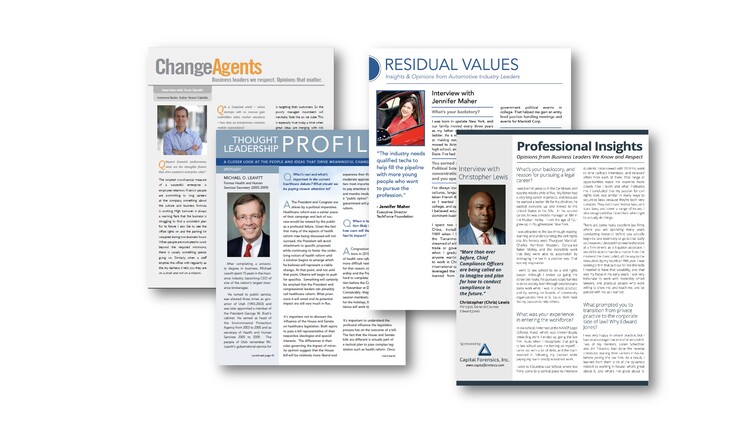
Traditional thought leadership – whether it’s delivered through owned media or earned media – most often involves showcasing your own ideas and opinions, those of a client, or of an individual within your organization.
From a content marketing perspective, the shortcomings of traditional thought leadership include:
- the high noise factor, caused by market competition for attention
- the perception that thought leadership is mostly self-promotional
- the sad truth that few “thought leaders” have anything interesting to say
- the challenge of producing new or interesting insights on a consistent basis, and
- the reality that your target audiences are unlikely to read your long-form commentary.
The Alternative to Traditional Thought Leadership
The underlying assumption of “Enlightened” thought leadership is that managing the conversation (on any topic) by showcasing respected, credible 3rd parties is far more effective than promoting your own, your client’s, or your company’s opinions and insights.
In other words, you must put ego aside, and acknowledge that your “internal” intellectual capital can be worth less than credible outside voices that you deem to be worth hearing, and whose message supports and validates your company’s value proposition.
This somewhat contrarian approach to thought leadership…delivered in an editorial format that we call Branded Interviews…is the most effective way for B2B companies of all types to build brand stature, and to connect the dots between marketing and sales. Hands down.
In a nutshell, Branded Interviews are:
- Interviews with recognized, respected opinion leaders with credentials related to your industry or professional discipline. They should not feature employees or clients
- Presented in a quick-reading Q&A editorial format, with 10 – 12 questions that highlight the individual’s personal and professional background, insights, and opinions
- Purely objective in nature. Guest comments should not mention or promote your business in any way
- Published on a quarterly or bi-monthly basis; distributed to clients, prospects and referrals sources; and promoted on LinkedIn…ensuring top-of-mind awareness with target audiences
- Valuable due diligence assets for your sales team to use with prospects
- Inherent 3rd party endorsements that should be archived in a dedicated section on your website
In truth, Branded Interviews require considerably more time and effort than traditional thought leadership content, even compared with what’s involved in generating bylined articles in respected business publications. The strategic selection and solicitation of guests, the development of relevant questions, the interview logistics, the conversion of an interview transcript to concise written responses, and the approval process, all take time and finesse. But the end-product is well worth all that work; producing evergreen content with unmatched credibility, and countless marketing and sales applications.
It’s Not About the Content. It’s About the Relationships.
Perhaps the most compelling reason to convert to enlightened thought leadership is that the publication development process itself has tangible value, in terms of establishing and building relationships with influential individuals who can make things happen for your company.
For one of our clients – an emerging healthcare technology company – their Branded Interview led to a relationship between the firm’s CEO and the interview guest that resulted in acquisition of the company at a significant multiple, which was the CEO’s intended exit strategy.
Asking a recognized opinion leader (that your firm may have no connections with) to be profiled in your Branded Interview may seem like a long shot, as well as a formula for embarrassment if the opinion leader declines. But the invitation process serves to put your company on his / her radar screen, and is flattering to the individual, whether or not they accept. Very often, high profile individuals do accept invitations to be interviewed simply because, like most people, they enjoy telling their story, and sharing their ideas.
In our view, Branded Interviews are an important and cost-effective way for B2B companies to get noticed and build brand stature, and should be a core tactical component in an integrated marketing strategy.
Before initiating a Branded Interview program, however, there are two important caveats:
- This is not a short-term marketing tactic designed to produce an immediate market response. It’s a sophisticated, longer-term approach that will yield tangible marketing and sales benefits over time.
- Lacking a senior management commitment to produce at least four Branded Interviews over the course of a year, B2B firms should pass on this marketing tactic.
Give me a call if you’d like to learn more reasons why we’re such big fans of Branded Interviews.
Filed under Uncategorized
Diet, Exercise And Marketing: Self-Imposed Obstacles That Ensure Failure

There are practical reasons diet companies and national gym chains spend most of their advertising budgets within two seasonal windows: in advance of the new year, when people make their annual resolutions, and in springtime, when beachgoers face the prospect of wearing a bathing suit in public.
Despite best intentions, many people who join gyms in January are likely to drop out in February, and many other new members will drop out within the next few months. Countless research studies also suggest that many people who lose weight will regain all of those pounds within a year, and likely add more.
There are valid social and physiological reasons most people don’t do the things necessary to maintain their personal health and fitness. On their journeys, they also must overcome self-imposed obstacles, and in my opinion, three of those are the same reasons marketing fails at most companies.
1. Setting Unrealistic Expectations
Regardless of our body shape, age and metabolism, we typically seek chiseled six-pack abs and movie-star good looks. In marketing as well, we often establish lofty goals — whether they involve lead generation, revenue growth or new accounts — that require a level of investment or period of time that far exceeds actual resources. Having “stretch goals” can be a healthy practice, but at too many companies, consistently falling short of unrealistic targets often results in shelving the marketing initiative altogether.
If there is no benchmark data from prior campaigns, companies are more likely to succeed if they begin with very low (or even zero) performance expectations. Whatever outcomes are achieved over the course of the campaign are then closely and consistently examined to determine what’s working and what’s not in order to make necessary adjustments. That way, there’s a much greater likelihood that the campaign will yield increasingly better results over time.
2. Searching For A Magic Bullet
Fad diets and weight-loss supplements can provide temporary solutions for people seeking alternatives that are faster and easier than changing their eating habits or exercising on a regular basis. Similarly, some companies are always seeking a marketing tactic or gimmick in hopes of generating immediate results.
Two current examples of perceived magic bullets include content marketing and marketing automation software. In both cases, companies can mistakenly believe that producing and sharing content, or consistently emailing information to prospects, is a guaranteed fast track to higher market response and business growth. But those two tactics will never deliver meaningful outcomes unless the company produces content that’s of interest to target audiences, and unless it defines and monitors the metrics it wants its marketing automation to achieve. Neither of those initiatives are quick fixes.
3. Lacking A Meaningful Plan
“Lose weight” is not a plan. Instead, a plan might be: “Lose 10 pounds over the next three months by monitoring my caloric intake; running two to three miles on Monday, Wednesday and Saturday; and logging my weight every morning.”
Each time I’ve met with a prospective client over the past three decades, one of the first questions I ask is, “Do you have a written marketing plan?” Some are truthful and tell me no. Others tell me they have a plan, but that it’s not written; to which my response is always, “Then you don’t really have a marketing plan.”
Some companies do have a written marketing plan. Typically, it’s contained in a three-ring binder that never gets looked at — and those companies don’t have a real marketing plan either. As a result, all of those companies have no tangible way to plan, budget for or execute meaningful marketing activity. There is no way to calculate the return on their marketing investment. There is no real accountability — no connection with the company’s sales function or with business metrics that can have an impact on its balance sheet.
Marketing’s Place At The Management Table
Too often, marketing is marginalized as a way to “promote the brand” or to “build goodwill,” and is viewed as overhead rather than a profit center. But for company owners or senior managers who are serious about tapping into the enormous potential of marketing to grow their enterprise, there is a pathway to avoid the three most common self-imposed obstacles:
• Treat marketing as an essential corporate discipline that requires the same level of commitment and long-term perspective as operations, sales, legal, accounting, technology or HR functions. Marketing should not be ignored or reduced when business is good, nor should it be applied only as triage when business declines. Marketing needs to run at a consistent pace at all times.
• Accept that there is no “secret sauce” in marketing that will transform the company overnight. The most meaningful marketing initiatives will take planning, hard work, and ongoing scrutiny and modification to produce results.
• Create written marketing plans that are realistic and user-friendly. They need not be lengthy or complex, and can be as brief as a two- to three-page memo. Your programs should be based on actionable, measurable tactics that are focused on driving market engagement rather than opinion, and that are not sacrosanct. If they’re not working, they’re fixed or replaced.
Management consulting legend Peter Drucker said, “Because the purpose of business is to create a customer, the business enterprise has two — and only two — basic functions: marketing and innovation. Marketing and innovation produce results; all the rest are costs.”
Given the actual role that marketing currently plays at most companies, Drucker — who passed away in 2005 — would likely need to modify his bold statement: “Marketing and innovation can produce results; all the rest are costs.”
Marketing’s full potential will be realized only by those companies with the insight to give the function a seat at the management table and the determination to make marketing earn its place there.
Filed under Uncategorized
Are Pitch Letters The Cinderella Of Content Marketing?
 Great content can build brand stature and increase market awareness, but in my experience, neither of those achievements necessarily delivers the type of market engagement that results in new accounts or revenue growth.
Great content can build brand stature and increase market awareness, but in my experience, neither of those achievements necessarily delivers the type of market engagement that results in new accounts or revenue growth.
Most marketing content is distributed through pull tactics, in which blog posts, social media posts, press releases, etc., expose information indirectly to a large audience. Pull-based content marketing is a shotgun approach. You’re firing at a flock of ducks, hoping you might hit a few.
Many marketing professionals argue that marketing automation technologies enable them to drive engagement by monitoring how specific individuals within their target audiences react to their content. For example, if a few ducks are hit by their initial shotgun blast — perhaps by clicking on a blog post link — the marketer can then identify and attempt to take down those particular ducks with another more targeted round or two.
Marketers also use push content to communicate directly with large groups of individuals. This shotgun tactic pushes out generic content through blast emails, direct (snail) mail and cold calling. That content often lands in spam folders, office trash cans and voicemail.
Trade Your Shotgun For A Rifle
How can you use content in a more strategic manner to turn more ducks into customers?
First, stop using ideas and solutions that might apply to all of the ducks in the flock, and instead leverage ideas and solutions that are likely to apply to specific, high-value ducks. Second, take down those targeted ducks with a rifle, not a shotgun.
Both requirements are addressed by unsolicited pitch letters, which is the only genre of content marketing that delivers tailored content through a personalized solicitation process.
How Unsolicited Pitch Letters Work
Because they require in-depth research, must be well-crafted and cannot be mass produced, very few firms leverage unsolicited pitch letters. They’re the Cinderella of content marketing. But over the past 25 years, unsolicited pitch letters have served as my firm’s only method of generating new business, other than referrals. The tactic has worked very well for several reasons. Notably it:
• Allows us to be selective about the types of companies we would like to have as clients.
• Differentiates my firm from competitors in terms of marketing sophistication.
• Incentivizes prospects to respond to our solicitation because the content applies only to them.
• Often eliminates or avoids any type of competitive shootout or request-for-proposal process altogether.
Unsolicited pitch letters are unlike any other form of content marketing for two reasons: One-size-fits-all content isn’t applied, and ideally, they’re sent directly to the highest-ranking decision maker within the target organization. Most often, that’s the CEO, managing partner or owner of the business.
Here are a few of the logistics involved in using unsolicited pitch letters:
• The process begins with research. The essential ingredient in an effective pitch letter is the time you invest in researching a prospective client. Go far beyond their website, and review all the public-facing information available, as well as the company’s competitive landscape.
• Identify a pain point, opportunity or both. The research goal is to identify a problem or opportunity that’s likely to be of great interest to senior management. It may involve a product or service shortcoming that puts them at a competitive disadvantage or a new idea that can reduce operating costs. Make sure that it’s always related to your own firm’s core capabilities.
• Don’t be afraid to criticize the prospect. As long as your ideas are relevant and presented in a professional manner, most prospects will not object to learning about problems or opportunities. In fact, many will welcome an objective outside opinion, even if you are delivering bad news.
• Grab their attention. If you’re sending a pitch letter by email, use a subject line that will increase the likelihood it will be opened. Use the name of the company, and consider referencing the idea you’re pitching. For example: “Our Review of Smith & Company’s Customer Service Capability.”
• Tease. Don’t pontificate. The end goal of the pitch letter is to engage the prospect in a face-to-face or phone conversation. You want to provide a point of view that suggests to the prospect that you’ve invested time in learning about their company and that you have some specific ideas that may be of interest to them. Make them want to learn more.
• Keep the pitch short. The most effective pitch letters are no longer than five or six sentences, with no large blocks of copy. Do not elaborate on your firm’s credentials. Your pitch is based on the quality of your ideas, not on the work you’ve done for others.
• Don’t bother to follow up. My firm’s experience is that the prospect will either respond to a pitch letter quickly or not at all. Don’t send multiple pitch letters or follow up on the phone. That’s not only a waste of time; it can also sour the prospect on doing business with you in the future.
• Check conditions six or 12 months later. Since you’ve invested the time to research the prospect and draft an effective pitch letter, it’s worthwhile to conduct follow-up research on a target company to see whether any changes related to your letter are evident. If not, it’s acceptable to forward your original pitch to the same targets, asking them to reconsider your offer.
• Hang in there. Similar to any sales tactic, you’re playing a numbers game. But if you conduct proper research and pitch relevant ideas on a consistent basis, your solicitations will likely yield meaningful results.
There are many reasons traditional content marketing approaches make sense: notably to maintain your firm’s reputation as a thought leader. But when it comes to the use of content to drive revenue growth, a sophisticated and disciplined pitch letter program has the potential to far exceed the yield of any other push or pull marketing tactic, particularly for small- and medium-sized companies.
Filed under Uncategorized
Is Your Firm a “Safe Choice” for Prospective Clients?

Prospective clients certainly want to know if you have the experience and skills they need. But before they put you on their short list of candidates for consideration, they first will need some assurance that your company is a “safe choice.” The hard reality is that — regardless of your firm’s ability to add value — decision-makers at every level are unwilling to risk their career or reputation on selection of an outside advisor or firm may fail to meet expectations, or even harm their business.
To make matters worse, prospective clients will decide to include or exclude you from their short list long before they talk with you, or meet you in person. Before reaching out to you or sending an RFP, prospects will determine whether your firm is a “safe choice” based on the same method they use to select a restaurant, a movie or golf course. They’ll form an opinion based on publicly available information they find online.
Unfortunately, simply telling target audiences — in your public-facing marketing assets — that your company is smart, honest, unique, innovative, creative, cutting-edge, trusted, etc. rarely succeeds. Prospects will require both hard and soft evidence to support their decision to include you as a serious candidate.
Most importantly, prospects need to feel confident that when their boss, partner, board of directors or spouse ever has cause to ask, “Why did you hire those guys?” that they will be able to provide a strong, defensible, well-reasoned “CYA” response.
If, as the outdated adage suggests, that “nobody has ever been fired for hiring IBM,” then how do you make the short list of candidates if you’re not IBM, and trying to survive in a world where you’re considered a risk even before you’re given an opportunity to succeed or fail?
Here are some tangible and intangible factors that, on an individual and combined basis, can drive marketplace opinion on whether you or your firm is a “safe choice”:
- Transparency: Is information regarding your firm’s philosophy, products / services, processes and people available and easily accessible? (Acid Test: How much digging is required to gain a basic understanding of your value proposition?)
- Consistency: Is all your information kept up-to-date, and relevant to current market conditions? (Acid Test: What’s the frequency and quality of content generation, as well as the number of direct and indirect “touches” with target audiences?)
- Enthusiasm: Does your firm appear genuinely enthusiastic about its business, and its communication with target audiences? Or does activity seem “cookie-cutter,” and communication appear to be treated as a necessary evil? (Acid Test: How often are innovation, provocative thinking and fun baked into those efforts?)
- Core Values: Are your company’s core values expressed in a compelling manner, to address the need to know what you stand for? More importantly, are those core values demonstrated through its actions? (Acid Test: Are they aspirational and inspirational? Is there tangible evidence that your core values really drive decision-making?)
- Culture: Is there a visible common culture, beyond shared academic credentials or charitable activities? Are there tangible signs that employees are valued, have a unified vision and enjoy working together? (Acid Test: Other than the annual mud run photo, do employees appear to be engaged as a team?)
- Associations: Who and what are the people, organizations, ideas and causes associated with your firm? Are those connections — perhaps reflected thought a Board of Advisors — respected, credible and trustworthy? (Acid Test: Is the firm actively connected with the outside world?)
- External Validation: How is your firm’s value proposition confirmed by objective 3rd parties? Do reliable sources express open support or inherent endorsement? (Acid Test: Do credible media sources or research firms cover the company? Do clients identify themselves by name and company?)
- Thought Leadership: Are efforts made to share / promote your firm’s intellectual capital in a helpful manner that’s not directly self-serving? (Acid Test: Do other opinion leaders reference your firm’s ideas or contributions? Are white papers just poorly disguised sales collateral?)
- Persona: Does your firm appear to be run by interesting human beings, or hide its personality behind an opaque, institutional veneer? (Acid Test: Does the overall impact of public-facing communication project warmth and sincerity, or distance and arrogance?)
Short of claiming a long client list of successful companies that your prospects want to emulate, there’s no magic formula that will increase your firm’s ability to be perceived as a safe choice. But as decision-making regarding selection of outside resources is increasingly based on a Google search, your firm can greatly improve its chances of making the short list by managing its online visibility in a more strategic manner.
Filed under Uncategorized


